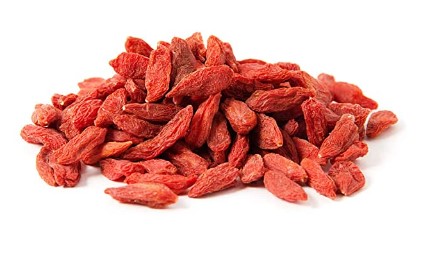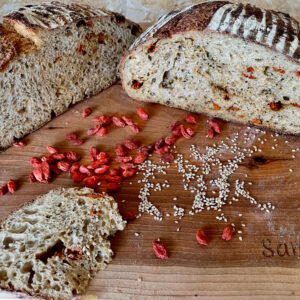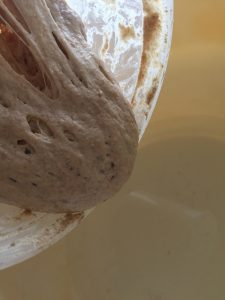0 Comments
share this

I decided to develop this goji berry, chia, sesame sourdough bread as a superfood bread. Ever had goji berries? Goji berries have been used in traditional Chinese medicine for centuries. Growing up, my grandmother often put these berries in soups and stews. We grew the plant in our back yard and ate both the berries and the leaves. I didn't realize the amazing health benefits of goji berries until I researched natural remedies for pre-diabetes and insomnia! I incorporate it in my soups, a refreshing tonic and many times just eat it as a snack. It is considered a superfood! I decided to make this "Asian inspired", goji berry, chia, sesame sourdough bread which is not only healthier, but the goji berries almost taste like sundried tomatoes with a combination of sweet and tart.
I also add chia seeds to this bread because of its health and hydrophilic properties which helps keep the bread most and does provide additional health benefits.
Tips for making goji berry, chia, sesame sourdough bread
Goji berries
Goji berries are usually found in the dried form in many Asian grocery stores. They are also known as wolfberries. Nutritionfacts.org states "Goji berries have the highest concentrations of melatonin and the third-highest antioxidant capacity of any common dried fruit—five times more than raisins and second only to dried pomegranate seeds and barberries. Gojis also have a specific antioxidant pigment that makes corn yellow—zeaxanthin. When eaten, zeaxanthin is shuttled into our retinas and appears to protect against macular degeneration, a leading cause of vision loss."
According to healthline.com, here are the health benefits of goji berries
Just 5 tablespoons (28 grams) of dried goji berries:
- Calories: 98
- Protein: 4 grams
- Fat: 0.1 grams
- Carbs: 21.6 grams
- Fiber: 3.6 grams
- Sugar: 21.8 grams
- Iron: 11% of the Daily Value (DV)
- Vitamin A: 501% of the DV
- Vitamin C: 15% of the DV
Chia seeds
According to healthline.com, here are the health benefits of chia seeds.
A one-ounce (28 grams) serving of chia seeds contains (1):
- Fiber: 11 grams.
- Protein: 4 grams.
- Fat: 9 grams (5 of which are omega-3s).
- Calcium: 18% of the RDI.
- Manganese: 30% of the RDI.
- Magnesium: 30% of the RDI.
- Phosphorus: 27% of the RDI.
- They also contain a decent amount of zinc, vitamin B3 (niacin), potassium, vitamin B1 (thiamine) and vitamin B2.
The seeds require rehydration before adding them into the bread dough mixture. The chia requires a long soak. If you forget to soak the seeds, add boiling water to the seed mixture to expedite the absorption. The chia seeds, when completely hydrated will allow a spoon to stand on end!

Goji berry, chia, sesame mixture
Like most of my sourdough breads, I like to have the sourdough starter work for this goji berry, chia, sesame sourdough bread to produce the most nutritious bread. This recipe has a long cold proof but rest assured, it does have maximum health benefits. Enjoy this nutritious and moist goji berry, chia, sesame sourdough and let me know how you like the added goji berries!
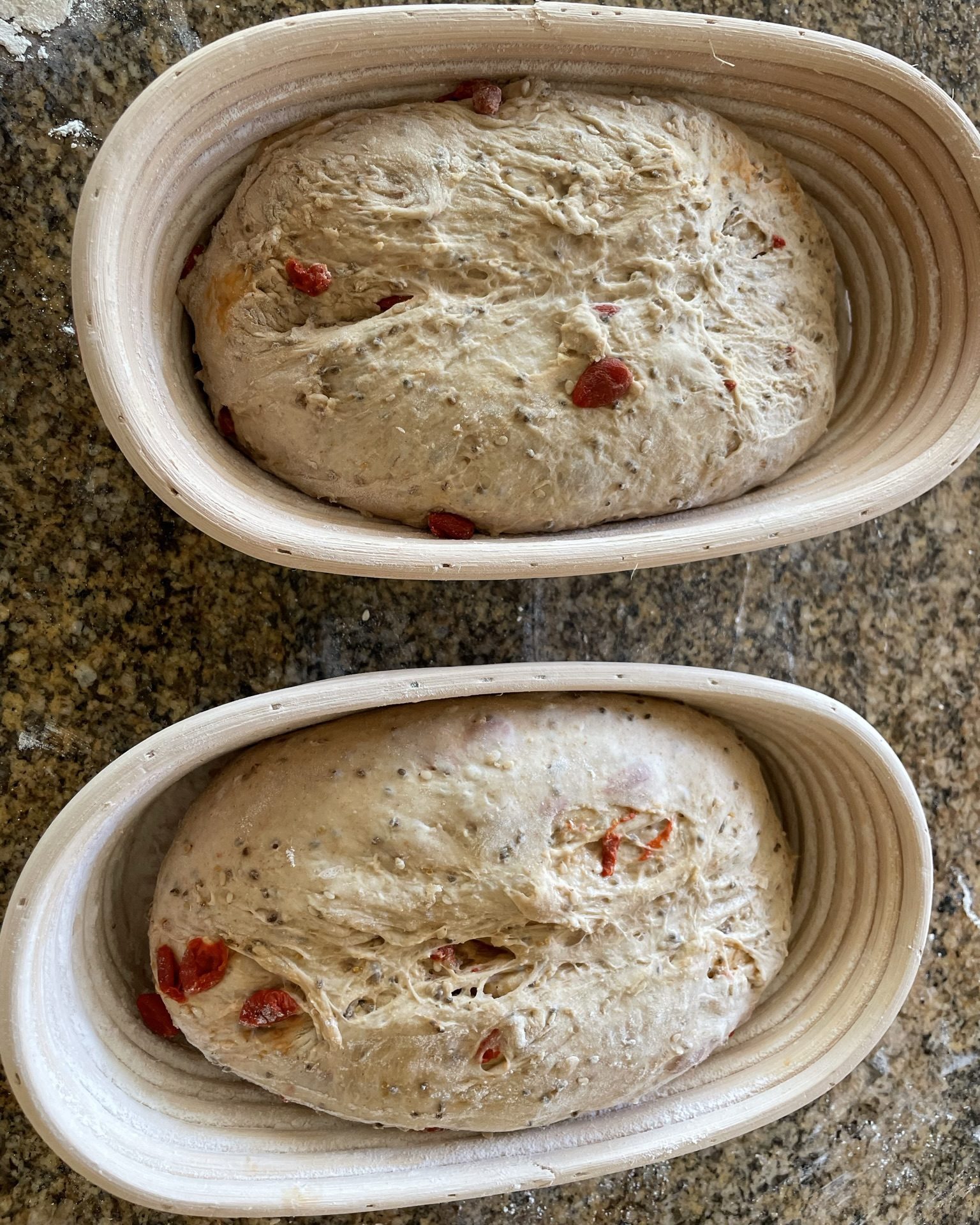
Sourdough in the bannetons.
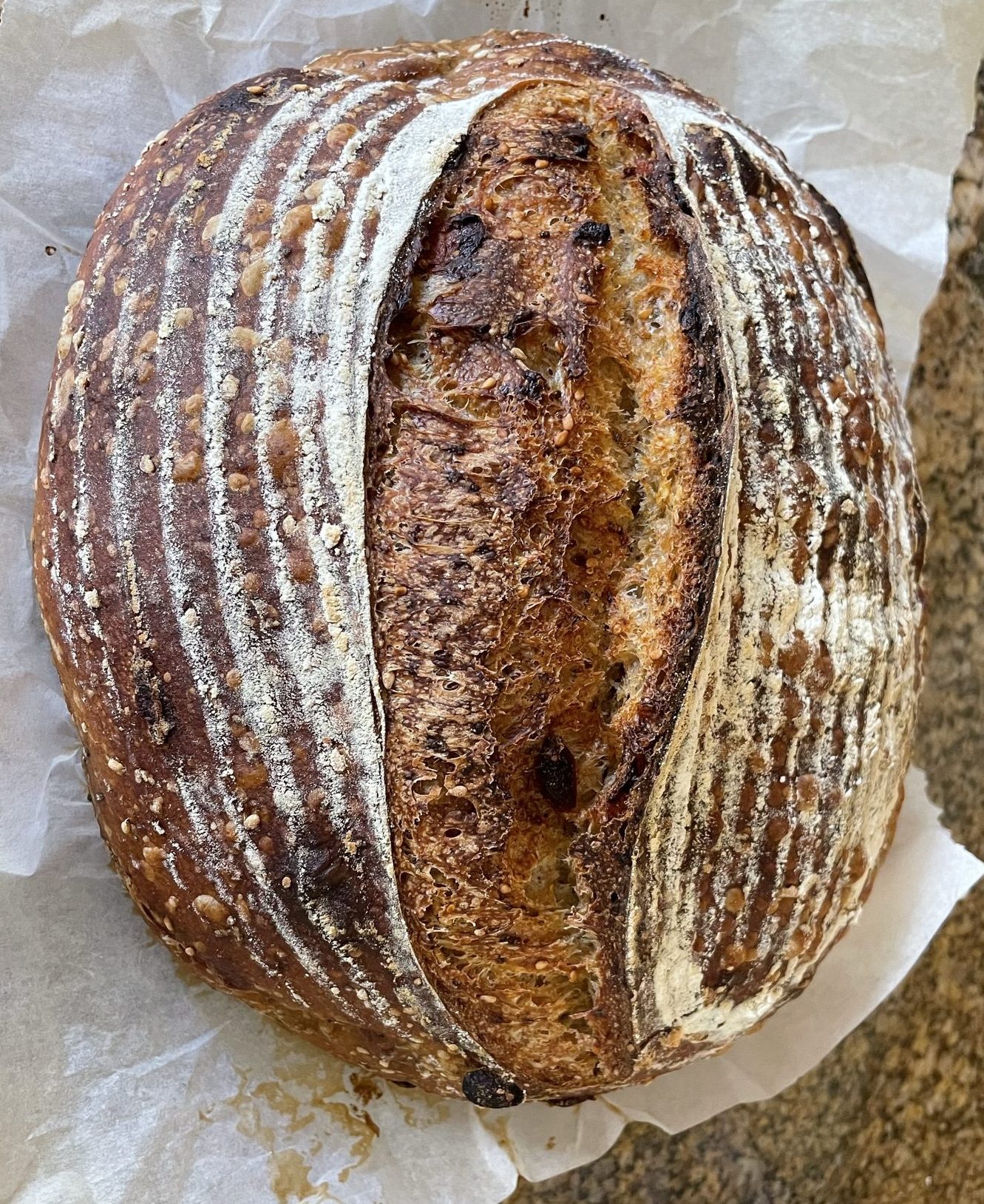
Baked goji berry, chia, sesame sourdough.
GOGI BERRY, CHIA, SESAME SOURDOUGH BREAD
Equipment
- Cast Iron dutch oven
- 2 Large Bowls
- Bread lame, razor or pair of scissors
- Dish towel to cover dough
Ingredients
- 350 grams water Room temperature water
- 400 grams bread flour
- 100 grams whole wheat flour
- 9 grams salt
- rice / bread flour mixture Used for dusting your proofing bowl / banneton
- 100 grams levain See "What is levain and how to make it"
- 40 grams dried goji berries
- 20 grams chia seeds
- 20 grams sesame seeds
- 100 grams boiling water for hydrating seeds
Instructions
Preparing your ingredients
- Prepare you levain, making sure it is very active.100 grams levain
- Measure and soak your wheat flour in the water.100 grams whole wheat flour, 350 grams water
- Soak your add-ins.40 grams dried goji berries, 20 grams chia seeds, 20 grams sesame seeds, 100 grams boiling water
Making your bread dough
- Sift you bread flour into a bowl. I do this because some bread flours are very refined and clumpy. Sifting helps remove those clumps.400 grams bread flour
- In another bowl, add your levain to your water-whole wheat flour mixture and stir to combine. The levain does not have to dissolve.
- Mix in your bread flour and let sit for 45 minutes. This allows your dough to autolyze, allowing the flour to completely absorb all the liquid making it easier to work with.Set timer for 45 minutes
Bulk fermentation.
- The dough is now ready for bulk fermentation where it will develop its flavor and body! Ambient temperatures between 70-80 degrees Fahrenheit will take 2-3 hours for bulk fermentation
- Add salt after the dough has autolyzed.9 grams salt
- I stretch and fold the dough by hand...very therapeutic. Using wet hands, I pull and stretch the dough out at the top and fold it back on itself, I then rotate the dough a quarter turn and do the same thing 16 times. (4 complete revolutions!)
- Let dough rest for 30 minutes. You will notice that the dough will become more pliable with time. Cover and let sit for 30 minutes. Don’t forget to set your timer! Set timer for 30 minutes
- It is also at this time when I will add add-ins to the dough. Stretch and fold.
- Let it rest for 30 minutes.Set timer for 30 minutes
- Stretch and fold.
- Let dough rest for 30 minutesSet timer for 30 minutes
- Stretch and fold.
- Let dough rest for 30 minutesSet timer for 30 minutes
- Stretch and fold.
- Let dough rest for 30 minutesSet timer for 30 minutes
- Stretch and fold.
- Let dough rest for 30 minutesSet timer for 30 minutes
- Stretch and fold. The dough should be soft and pliable. If not, continue bulk fermentation for another 30 mins - 1 hour.
Shaping your bread dough.
- Pull dough out of the container. You can make smaller bolles by using about 250 grams of dough (a half of your recipe). See Cutting and Shaping your Dough in my Tips & Tricks section.
- On a floured surface, lightly dust your dough with flour and work it into a round by pulling it towards you and rotating. It should become somewhat taut as you pull the dough, part of your goal is to remove most of the air bubbles that were created during the fermentation process. I have found that if you keep these air bubbles, your bread will be very porous with a lot of air bubbles (almost like a ciabatta). Some people like this, other people want a little more substance.
- Let it sit for 15 minutes. Set timer for 15 minutes
- Shape again. See Cutting and Shaping your Dough in my Tips & Tricks section.
- Prepare your banneton (Coiled rattan baskets for proofing) by generously dusting the bowl or banneton with your bread and rice flour mixture. Dust the tops of your loaves with flour and place it in a bowl or banneton with the dome side on the bottom of the banneton.rice / bread flour mixture
Proofing your dough - Quick Proof (not recommended)
- Cover your banneton with a damp cloth and let rise in a warm place for 2 hours. I usually put this in my oven with the oven light on.Proof dough for 120 minutes
- Take your dough out and preheat oven to 500° fahrenheit (260° Celcius) with your cast iron dutch oven in it. (Should take about an hour depending to get your cast iron pot to the desired temperature.) This will be a total of 3 hours of proofing. I have proofed bread for 4 hours. However, overproofing your dough with cause your dough to lose its ability to have enough strength for the "oven-spring" (the last rise in the oven as a result of intense heat).
Proofing your dough - Slow Proof (recommended)
- Allow dough to proof at room temperature for one hour before cold proofing.
- Place your banneton in a plastic bag. Seal it with a clip. Place it in the refrigerator for 24-48 hours. Highly recommend a 48 hour proof for the dough to develop its flavor
- Preheat oven to 500° fahrenheit (260° Celcius) with your cast iron dutch oven in it. (Should take about half an hour depending on your oven to get your cast iron pot to the desired temperature.)
Scoring your dough.
- The dough should be fairly firm but not impossible to handle after (cold) proofing. Take a piece of parchment paper that will generously cover the top of the bowl/banneton. Crumple it so that it folds easily in the dutch oven. Place it over the bowl/banneton.
- Flip the banneton over. The dough is now ready for scoring
- Dust the top of the dough with a little more flour if necessary or brush off excess flour from proofing. Score the bread by cutting it with a razor blade, bread lame, or a pair of scissors. Scoring the bread allows for oven spring when the dough expands quickly during baking and gives your dough a pretty design. See Scoring your dough in my Tips & Tricks section.
- Gently lower your scored bread into the dutch oven. If you have a cast iron skillet / dutch oven set as shown on my "Helpful Tools" section. After scoring, place the dough in the skillet of the set and cover the dough with the dutch-oven section. Place it in the oven with the skillet on the bottom.
- Cover.
Baking your bread
- Reduce oven temperature to 450°F
- Bake for 25 minutes. Smaller 2 quart bolles should bake for 20 minutes.Set timer for 25 minutes for large bolle Set timer for 20 minutes for small bolle
- Remove the lid and continue baking for an additional 25 or 20 minutes respectively.Set timer for 25 minutes for large bolle Set timer for 20 minutes for small bolle
- Remove from oven and remove from dutch oven and let cool on wire rack.
- To bake the second loaf, after removing the first loaf, bring the oven temperature back to 500 degrees, wipe the dutch oven with a clean dry towel, place the dutch oven in it for 10 minutes and bake according to recipe.
- Bread should cool for at least an hour before attempting to slice into it!
Notes
Nutrition
DON'T MISS A RECIPE

